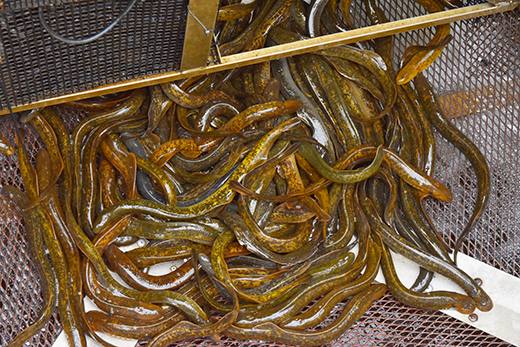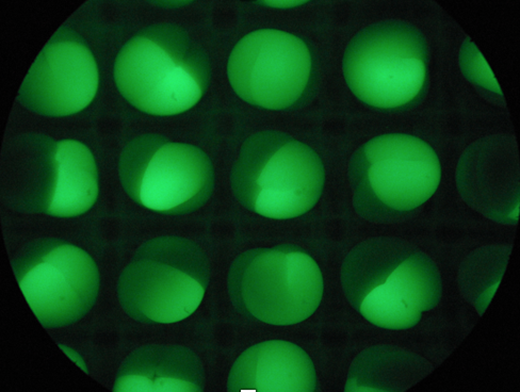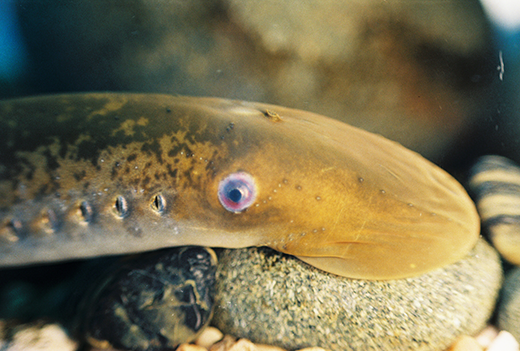Making the Best of a Bad Situation: Great Lakes Sea Lampreys Reveal the Origins of Vertebrate Traits
In a surprising twist of fate, sea lampreys—an ancient, parasitic Great Lakes invasive species—are yielding insights into the human body!
Many researchers across North America—and particularly in the Great Lakes region—intensely study the ecology of sea lampreys. But there are also researchers worldwide who study sea lampreys in hopes of making basic scientific discoveries, including discoveries with important implications for understanding growth and development in humans.
Despite the many obvious differences between sea lampreys and people, humans share many genes with sea lampreys. While that might at first seem undesirable (based on looks alone!), it could be beneficial. Sea lampreys are considered "model organisms"—organisms useful for answering fundamental biological questions—because they are located at the base of the evolutionary tree for vertebrates. Additionally, some aspects of sea lamprey anatomy and physiology are easier to study because they are simplified compared to other vertebrates, like humans, yet similar enough that insights into one species have relevance to the other. Another benefit to working with sea lampreys is that there is an abundant supply available every spring thanks to the thousands of spawning adults that are trapped through the GLFC’s control program. Though most of the captured sea lampreys are used for outreach and research into novel control methods, some are provided to researchers studying other aspects of sea lamprey biology. Below we highlight three areas of exciting research using Great Lakes sea lampreys with applications to human growth and development.

Adult sea lampreys in a trap on the Ocqueoc River in northeastern Michigan. Each year about 20,000 sea lampreys are trapped from Great Lakes streams. Credit: Andrea Miehls, GLFC.
Research Focus 1: Neural crest formation in vertebrates
Researchers are using sea lampreys to understand a fundamental step in vertebrate development – the evolutionary origin of the neural crest. The neural crest is an embryonic stem cell population that gives rise to a diverse "adult" cell lineage including the peripheral nervous system, pigment cells, and facial skeleton. Neural crest cells are unique to vertebrates and are essential to human development. Research with sea lampreys, the most primitive vertebrate from which embryos can be studied, is shedding light on the basic developmental mechanisms underlying neural crest formation, and on the evolution of the vertebrate neural crest. Read more about this research at: https://www.nature.com/articles/s41586-019-1691-4 and https://www.nature.com/articles/s41467-019-09197-8.

Sea lamprey eggs at the four-cell stage. Credit: Bronner lab.
Research Focus 2: Vertebrate brain development
Researchers are studying sea lampreys to gain insight into the evolution of certain brain structures within vertebrates. Researchers have found evidence that the lateral line and electrosensory nuclei—parts of the sea lamprey hindbrain which allow them to sense their surrounding environment—are likely the evolutionary precursor to the cerebellum. The cerebellum is the part of the brain found in all jawed vertebrates, including humans, that coordinates and regulates muscular activity. By studying these structures, researchers hope to gain a better understanding of the process of brain development in vertebrates. Read more about this research at: https://www.karger.com/Article/FullText/339868.

An adult sea lamprey resting on the rocks. The V-shaped bumps on the snout are part of a rudimentary lateral line - the likely evolutionary precursor to the cerebellum. Credit: Andrea Miehls, GLFC.
Research Focus 3: Evolution of vertebrate vision
Sea lampreys and humans share key structures involved in eyesight, specifically photoreceptors in the retina used to sense light. Consequently, researchers are using sea lampreys to learn how vision in vertebrates evolved. Recent work has revealed that the photoreceptors of sea lampreys are highly light sensitive, capable of detecting a single photon of light, much like the photoreceptors of jawed vertebrates, including humans. Accordingly, basic mechanisms of photoreception in vertebrates must have evolved early, already appearing nearly fully formed 500 million years ago. Read more about this research at: http://dx.doi.org/10.1016/j.cub.2014.12.031.

A spawning adult sea lamprey suctioned onto a rock. The eye is visible in the center of the photo. Credit: Ted Lawrence, GLFC.
By supporting research projects like these through the provisioning of sea lamprey specimens, the GLFC and many talented researchers make the most out of a bad situation by finding beneficial uses for this noxious Great Lakes invasive species.
Read more Pulse on Science: Project Spotlights
- New Study Concludes Invasive Sea Lampreys Can Be Controlled by the Release of Sterilized Males
- Happy 75th anniversary to Hammond Bay Biological Station!
- Great Lakes Habitat Restoration: Partnering to Promote Fish Production
- Sea Lamprey Control Spreads the Distance
- Making the Best of a Bad Situation: Great Lakes Sea Lampreys Reveal the Origins of Vertebrate Traits
- Studying the Fish of Buffalo Reef, Traverse Bay, Lake Superior
- Doing Science is Essential...Communicating Science is Just as Critical (and maybe more FUN!)
- Faithful Fish: Walleye Show High Spawning Site Fidelity in the Great Lakes
- Finding the Sea Lamprey's Kryptonite
- Good Things Come in...Polymer Packages?
- Rambunctious Reproduction Overheard Among Great Lakes' Lake Trout
- Clearer Water Means Less Fish: Understanding How Lower Trophic Level Changes Impact Lake Huron's Fisheries

